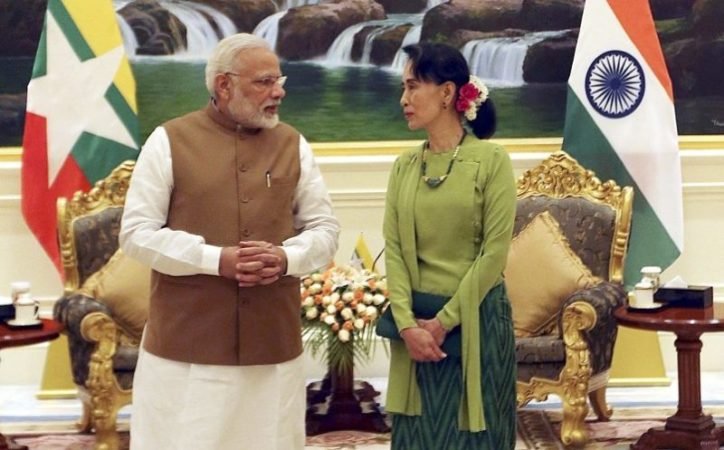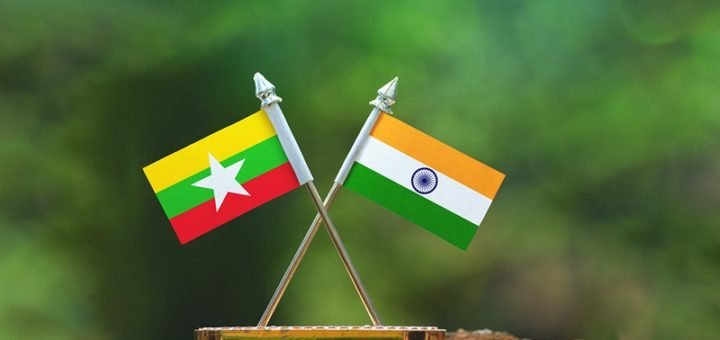COVID-19: India’s Regional Diplomacy In The Neighbourhood: A Case For Engaging With Myanmar

The images of Indian cargo ships delivering vital food and medicine to its neighbours have started pouring in on Twitter. This assistance aligns with India’s promise of extending timely help to its neighbour countries, as detailed by Prime Minister Modi in the recently held SAARC video conference. This timely humanitarian assistance and the exemplary leadership shown by the Indian Prime Minister have helped India garner much praise and have indeed given a facelift to India’s neighbourhood first policy. However, the picture is not consistent everywhere, especially in the eastern neighbourhood.
In the developing state of Myanmar, India’s eastern neighbour, sharing a land border of 1643 km and touching four states in the North-eastern region, Arunachal Pradesh, Nagaland, Mizoram, and Manipur, the story is different. Understandably, Myanmar is a part of the Southeast Asian nations and a member of the ASEAN regional grouping. However, its strategic location and China’s consistent efforts at deepening its ties, makes it worthy of our attention. China’s constant engagement with the Southeast Asian nations has only raked up in the advent of the COVID 19 pandemic. While India is fighting a battle in its home turf, it should play to it its strengths and extend its regional diplomacy to the extended neighbourhood, especially Myanmar. This presents India with a unique opportunity to engage with this developing nation, albeit in an hour of crisis.
China, an all-weather friend:
Much before Myanmar even reported its first COVID 19 positive case on March 23, China started extending its medical aid to Myanmar in the form of donations of Laboratory Equipment, reaching the state on March 18. This was followed with another tranche of medical donations in the form of Protective Personal Equipment (PPE), laboratory masks and respirators that were handed over to the Burmese Government on March 26. Chinese philanthropic organisations, including the Jack Ma Foundation and Alibaba Foundation, have also come forth with donations of medical supplies of test kits and N95 masks. The Chinese Ambassador to Myanmar, on his part, stressed that this assistance is in agreement with furthering the Paukphaw (fraternal) friendship between both the countries, evoked by President Xi Jinping during his seminal visit to Yangon in January this year.

Contest for influence:
Pandemic or not, China’s association with the country has been consistent, being one of the few countries that engaged with the junta government that was closed and isolated. The generous economic aid and political support that China showered on Myanmar continue till date. India was late in engaging with Myanmar and did so only after alarms of a growing Chinese presence in its periphery. Ever since there is a kind of contest for influence between India and China in Myanmar. Each is trying to take advantage of its strengths to augment their role and involvement in the country. Myanmar’s historical connection of being a part of British India till the mid-1930 and extensive cultural, linguistic and religious connection are the upsides that India enjoys. But at the same time, a strong ethnic Chinese community with considerable financial muscle and playing a key role in the country’s business activities has enabled China to position itself as a pivotal partner for Myanmar.
Read: Myanmar President’s visit: What does it mean to India?

Both India and China are rising powers of the region, the commonality of interests, as well as commonality in the aspirations, contributes to the imbalance in the relations, making it more competitive than cooperative. Since the strategic importance of Myanmar for both India and China remain paramount, both the countries are seen to be competitively engaged there. The manifestation of this competition in Myanmar is most prominent in certain domains such as in the pursuit of energy security, in the domain of infrastructure as well as in the strategic sphere. When India failed to secure the pipeline deal through Bangladesh, China was quick enough to come up with the tri-project of an oil and gas pipeline and a deep underwater crude oil port, connecting Kyaukpyu in Rakhine to the landlocked and less developed Yunnan province.
China has been heavily investing in infrastructure upgrades in a bid to facilitate connecting the landlocked southwestern provinces of Sichuan and Yunnan with the ports in the Indian Ocean. Access to these ports has ensured that China enjoys a privileged entry to Burmese markets. As a part of the Belt and Road Initiative, China is also planning to construct the China-Myanmar economic corridor connecting Kyaukphyu to Kunming. India, on the other hand, is focusing on the Kaladan Multi-Modal Transit Transport Project and the India-Myanmar-Thailand trilateral highway, India–Myanmar Friendship Road linking Moreh-Tamu-Kalemyo-Kalewa, and the Bangladesh, China, India, and Myanmar (BCIM) Economic Corridor: a multi-modal transport corridor connecting the four neighbour counties.

COVID 19: India’s role in this shared destiny
While the COVID 19 pandemic is a shared destiny of the entire humanity, India should play to its strengths and further its humanitarian mode of assistance, especially in its extended neighbourhood. For instance, once trials ascertain their feasibility, India can consider offering indigenously built low-cost ventilators to Myanmar, apart from extending other assistance. India did well to have evacuated citizens of Myanmar and a host of other countries, during its third batch of evacuation from the Hubei province of China. It merits to push the envelope now. Considering that China is furthering its aid diplomacy with ease and US Department of State announcing $3.8 Million in health and humanitarian funding towards COVID 19 management in Myanmar, the time cannot be more apt to act.

 for sending us vital food and medicine at this difficult time.
for sending us vital food and medicine at this difficult time. 
















